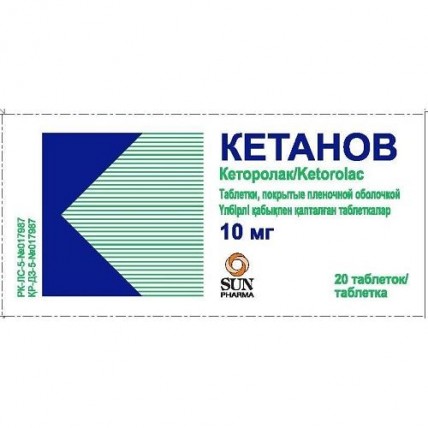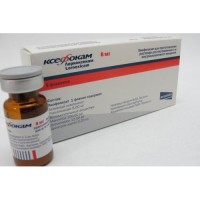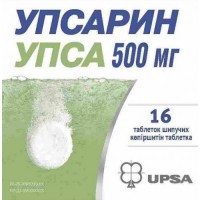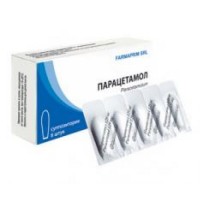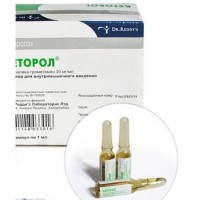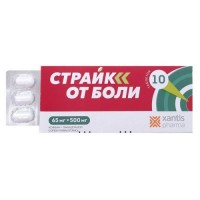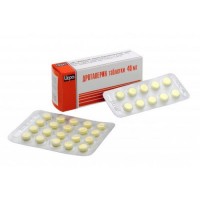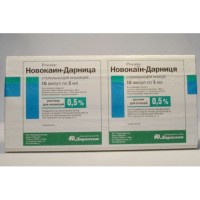Ketanov 20s 10 mg coated tablets
- $5.50
The instruction for medical use
of Ketanov Torgovoye medicine a name
Ketanov
the International unlicensed
name Ketorolak Lekarstvennaya
the Tablet form, film coated 10 mg Structure
One tablet contains
active agent - a ketorolak of a trometamin of 10 mg
excipients: microcrystalline cellulose, starch corn, silicon dioxide colloidal, magnesium stearate
cover: a hydroksipropilmetiltsellyuloza, the macrogoal-400, talc purified the titan E171 dioxide.
The description
of the Tablet from white till almost white color, round, biconvex shape, film coated, with the squeezed-out inscription KVT on one party Pharmacotherapeutic group
Non-steroidal anti-inflammatory drugs. Acetic acid derivatives
the Code of automatic telephone exchange M01AB15
the Pharmacological
Ketorolak's Pharmacokinetics properties trometamin is quickly and completely soaked up after oral administration. The maximum concentration in plasma makes 0.87mkg/ml in 50 minutes after reception of a single dose 10 mg. More than 99% of a ketorolak contact proteins of plasma.
The pharmacokinetics of a ketorolak at people after introduction single and repeated doses has linear character. Equilibrium concentration of drug in blood plasma is established in 1 day after quadruple introduction. Changes of pharmacokinetics after administration of drug in chronic diseases were not noted. After introduction of a single intravenous dose the volume of distribution is 0.25 l/kg, elimination half-life - 5 hours, clearance of 0.55 ml/min.
91.4% of a ketorolak and its metabolites (conjugates and a p-hydroxymetabolite) it is removed with urine, the rest is removed with excrements.
Plasma elimination half-life averages 5.4 hours. At elderly patients (at the age of 72 years) elimination half-life makes 6.2 hours. Food rich with fats reduces level, but does not affect completeness of absorption, antacids also do not influence the size of absorption of a ketorolak.
The pharmacodynamics
Ketanov non-steroidal anti-inflammatory drug (NPVS), possesses analgeziruyushchy, anti-inflammatory and moderate febrifugal action. Ketorolaka trometamin inhibits synthesis of prostaglandins by non-selective oppression of activity of TsOG-1 and TsOG-2, mainly in peripheral fabrics.
Indications
- a pain syndrome of moderate expressiveness
the Route of administration and doses
For oral administration.
The tablets Ketanov are appointed preferably in time or after a meal.
Ketones in tablets on 10 mg it is recommended only for short use (up to 5 days) and it is not recommended for treatment of chronic pains.
Adults and teenagers are more senior than 16 years with the body weight exceeding 50 kg
If necessary each 4-6 hours apply 10 mg. It is not recommended to exceed a dose of 40 mg a day.
Upon transition from parenteral administration of Ketanov, the dose of both dosage forms should not exceed 90 mg (60 mg - for elderly patients, patients with a renal failure and also patients with body weight less than 50 kg) and at the same time the drug dose in tablets in day of transition should not exceed 40 mg. Patients have to be transferred to an oral way of introduction to the shortest period.
Elderly patients
drug Use to elderly patients can be followed by the increased risk of development of serious side reactions. It is necessary to use the smallest effective dose during the shortest period of use. Use of longer intervals between doses, for example, is allowed 6-8 hours.
Against the background of therapy it is necessary to carry out by non-steroidal anti-inflammatory drugs regular control of a condition of the patient in case of developing of gastrointestinal bleeding.
Side effects
- dryness in a mouth, a stomacace, nausea, vomiting, a stomach ache, feeling of overflow of a stomach, gastritis, an esophagitis, an eructation, a meteorism, a constipation, diarrhea, pancreatitis, exacerbation of colitis and Crohn's disease, GIT erosive cankers, including perforation or gastrointestinal bleedings (a melena, vomiting like a coffee thick)
- concern, a disorder of vision, including illegibility of visual perception, an optic neuritis, drowsiness, insomnia, unusual dreams, dizziness, a headache, perspiration, nervousness, paresthesia, functional disturbances, pathological thinking, a depression, spasms, a polydipsia, inability to concentrate, concern, fatigue, excitement, a spatial disorientation, disturbances of taste, myalgia, confusion, hallucinations, a hyperkinesia, a hearing loss, sonitus, aseptic meningitis (especially at patients with the available autoimmune disorders, such as system lupus erythematosus, diseases of connective tissue)
- urination increase, an oliguria, a hyponatremia, a hyperpotassemia, a back pain (with or without hamaturia), increase in concentration of urea and creatinine in blood serum, interstitial nephrite, an ischuria, a nephrotic syndrome, an acute renal failure, an azotemia, a gemolitiko-uraemic syndrome (hemolytic anemia, a renal failure, thrombocytopenia, a purpura), swell renal genesis
- abnormal liver functions, hepatitis, a hepatomegalia, cholestatic jaundice, a liver failure
- bradycardia, pallor, arterial hypertension, heart failure, a myocardial infarction or a stroke
- a fluid lungs
- thrombocytopenia, a neutropenia, an eosinophilia, an agranulocytosis, aplastic anemia, hemolytic anemia
- a purpura, skin rash, an itching, a small tortoiseshell, photosensitivity of skin, Stephens-Johnson's syndrome, a toxic epidermal necrolysis (Lyell's disease), exfoliative dermatitis, makulopapullezny rashes
- allergic reactions: an anaphylaxis or anaphylactoid reactions (pain and weight in a thorax, bronchial asthma, a bronchospasm, a tachypnea, a laryngeal edema or dispnoe, a Quincke's edema, violent dermatitis, swell a century, periorbital swelled)
- postoperative bleedings from wounds, hematomas, nasal bleedings, increase in a blood clotting time
- an asthenia, inflows, swell (persons, shins, anklebones, fingers, a foot), it is rare - a paraglossa, increase in weight, fever
-
Contraindication infertility
- hypersensitivity to a ketorolak, to excipients or other NPVS
- GIT erosive cankers in an active phase or gastrointestinal bleedings, formation of ulcers or their perforation in the anamnesis
- the profound heart, liver failure or an active phase of a disease of a liver, a renal failure of average and heavy degree (creatinine of blood serum & gt, 160 µmol/l)
- a state after performing aortocoronary shunting
- suspicion or the confirmed cerebrovascular bleeding
- hemorrhagic diathesis, fibrillation disturbance
- a combination of bronchial asthma, the nose recuring a polypose and near-nasal bosoms and intolerance of acetylsalicylic acid or other NPVS (including. in the anamnesis),
- the allergic reactions including caused by reception of NPVS such as asthma, bronchospasm, rhinitis, Quincke's disease or small tortoiseshell called by reception of NPVS (in the anamnesis)
- to the patients accepting acetylsalicylic acid, other NPVS (including selection inhibitor of cyclooxygenase-2), okspentifillin, probenetsid or lithium salts
- a hypovolemia, dehydration
- bleedings or high risk of their development (patients, in the postoperative period, the accepting anticoagulants, heparin in a dose of 2500-5000 units in 12 hours, patients with hemophilia)
- a hyperpotassemia
- pregnancy and the period of a lactation
- children's age up to 16 years
Medicinal interactions
It is necessary to AVOID simultaneous use with the drug Ketanov:
- other NPVS, including selection inhibitors of cyclooxygenase-2
- anticoagulants (warfarin) and dezagregant as their combined use can cause bleeding
- lithium drugs as poisoning with lithium owing to decrease in its renal clearance and increase in concentration in blood plasma
- probenetsidy because of increase in level of a ketorolak in blood plasma is possible, and lengthenings of the period of its semi-removal
- NPVS it is not necessary to apply within 8-12 days after intake of mifepristone as the efficiency of mifepristone can decrease.
It is necessary to be careful at simultaneous use of Ketanov with the following medicines:
NPVS can provoke developing of heart failure, owing to reduction in the rate of glomerular filtration and increase in level of concentration of cardiac glycosides in blood plasma at their simultaneous use.
Ketanov can reduce effect of antihypertensives and diuretics, and risk of development of nephrotoxic effect of drug as a result increases.
Ketones reduces diuretic effect of furosemide by 20% therefore patients should appoint with extra care drug with a decompensation of warm activity.
There is an increased risk of developing of a renal failure at simultaneous use of Ketanov with inhibitors angiotensin - the converting enzyme.
It is necessary to be careful at simultaneous use of Ketanov with cyclosporine, takrolimusy because of the increased risk of emergence of nephrotoxic effects.
It is necessary to be careful at simultaneous use with corticosteroids because of the increased risk of developing of ulcers or gastrointestinal bleedings.
The risk of gastrointestinal bleedings at a concomitant use with antithrombocytic means, selective serotonin reuptake inhibitors increases.
Owing to the increased risk of developing bleeding at simultaneous use with okspentifilliny, such combination should be avoided.
It is necessary to be careful at simultaneous use with a methotrexate as increase it gepato- and nephrotoxicity is possible.
At the patients accepting hinolona the risk of developing spasms can increase.
Drug does not change linking of digoxin, warfarin, paracetamol, Phenytoinum and tolbutamide with blood proteins. Because ketorolak has low concentration in plasma, it is supposed that drug does not force out essentially other medicinal substances connected with proteins of plasma.
Special instructions
Undesirable effects can be minimized, using the smallest effective dose during the shortest period of the use necessary for stopping of a pain syndrome.
Use at elderly patients: at elderly the increased frequency of development of side reactions after administration of drug (perforation, gastrointestinal bleedings) which can lead to the death of the patient is observed. This age risk belongs to use of any drug from the NPVS group. In comparison with young adult patients, at elderly its elimination half-life from plasma owing to decrease in plasma clearance is extended. Therefore for this group of the population it is better to use longer intervals between administration of drug (6-8 hours).
From a respiratory system: it is necessary to appoint with care drug to the patients having bronchial asthma (including in the anamnesis), because of risk of development of a bronchospasm.
Use at patients with an abnormal liver function: at patients with an abnormal liver function owing to cirrhosis any clinically significant changes of clearance or final elimination half-life of a ketorolak were not observed.
Increase in one or several indicators of hepatic tests can be observed. These deviations usually are temporary, can remain not changed or to progress at further use. In case of development of clinical symptoms which meet in liver diseases or at system manifestations the drug use Ketanov should be stopped.
Considering features of influence of medicine on ability to run the vehicle or potentially dangerous mechanisms the available side effects of drug, such as drowsiness, dizziness, a spatial disorientation, insomnia, fatigue, a disorder of vision or a depression, at their emergence it is necessary to refrain from control of motor transport and work with potentially dangerous mechanisms.
Overdose
Symptoms: a headache, nausea, vomiting, pains in epigastric area, gastrointestinal bleedings, it is rare - diarrhea, orientation disturbance, excitement, a coma, drowsiness, dizziness, sonitus, a loss of consciousness, spasms. In a serious poisoning the acute renal failure and an abnormal liver function are possible.
Treatment: symptomatic therapy. At reception of potentially life-threatening dose it is necessary to make gastric lavage, to accept inside activated carbon.
If necessary monitoring of functions of vital functions of an organism and other medical and diagnostic actions taking into account a clinical condition of the patient is carried out.
The form of release and packing
On 10 tablets place in blister strip packaging from aluminum foil. On 2 or 10 blister strip packagings together with the instruction for medical use in the state and Russian languages place in a cardboard pack.
To Store storage conditions in the dry, protected from light place at
a temperature not higher than 25 S. Hranit out of children's reach!
3 years
not to use a period of storage after the expiry date specified on packing.
Prescription status
According to the prescription
Sun Pharmaceutical Ind Ltd Producer, India
Industrial Area-3 Dewas-455001
the Owner of the registration certificate
of Sun Pharmaceutical Ind Ltd, India
the Address of the organization accepting in the territory of the Republic of Kazakhstan claims from consumers on quality of products
Representation of Sun Pharmaceutical Ind Ltd in RK
Almaty, Manas St. 32 and, BC SAT the 6th floor, 602
ph.: 8-800-080-5202
el. address:
To develop regulatory.kz@sunpharma.com
of Ketanov Torgovoye medicine a name
Ketanov
the International unlicensed
name Ketorolak Lekarstvennaya
the Tablet form, film coated 10 mg Structure
One tablet contains
active agent - a ketorolak of a trometamin of 10 mg
excipients: microcrystalline cellulose, starch corn, silicon dioxide colloidal, magnesium stearate
cover: a hydroksipropilmetiltsellyuloza, the macrogoal-400, talc purified the titan E171 dioxide.
The description
of the Tablet from white till almost white color, round, biconvex shape, film coated, with the squeezed-out inscription KVT on one party Pharmacotherapeutic group
Non-steroidal anti-inflammatory drugs. Acetic acid derivatives
the Code of automatic telephone exchange M01AB15
the Pharmacological
Ketorolak's Pharmacokinetics properties trometamin is quickly and completely soaked up after oral administration. The maximum concentration in plasma makes 0.87mkg/ml in 50 minutes after reception of a single dose 10 mg. More than 99% of a ketorolak contact proteins of plasma.
The pharmacokinetics of a ketorolak at people after introduction single and repeated doses has linear character. Equilibrium concentration of drug in blood plasma is established in 1 day after quadruple introduction. Changes of pharmacokinetics after administration of drug in chronic diseases were not noted. After introduction of a single intravenous dose the volume of distribution is 0.25 l/kg, elimination half-life - 5 hours, clearance of 0.55 ml/min.
91.4% of a ketorolak and its metabolites (conjugates and a p-hydroxymetabolite) it is removed with urine, the rest is removed with excrements.
Plasma elimination half-life averages 5.4 hours. At elderly patients (at the age of 72 years) elimination half-life makes 6.2 hours. Food rich with fats reduces level, but does not affect completeness of absorption, antacids also do not influence the size of absorption of a ketorolak.
The pharmacodynamics
Ketanov non-steroidal anti-inflammatory drug (NPVS), possesses analgeziruyushchy, anti-inflammatory and moderate febrifugal action. Ketorolaka trometamin inhibits synthesis of prostaglandins by non-selective oppression of activity of TsOG-1 and TsOG-2, mainly in peripheral fabrics.
Indications
- a pain syndrome of moderate expressiveness
the Route of administration and doses
For oral administration.
The tablets Ketanov are appointed preferably in time or after a meal.
Ketones in tablets on 10 mg it is recommended only for short use (up to 5 days) and it is not recommended for treatment of chronic pains.
Adults and teenagers are more senior than 16 years with the body weight exceeding 50 kg
If necessary each 4-6 hours apply 10 mg. It is not recommended to exceed a dose of 40 mg a day.
Upon transition from parenteral administration of Ketanov, the dose of both dosage forms should not exceed 90 mg (60 mg - for elderly patients, patients with a renal failure and also patients with body weight less than 50 kg) and at the same time the drug dose in tablets in day of transition should not exceed 40 mg. Patients have to be transferred to an oral way of introduction to the shortest period.
Elderly patients
drug Use to elderly patients can be followed by the increased risk of development of serious side reactions. It is necessary to use the smallest effective dose during the shortest period of use. Use of longer intervals between doses, for example, is allowed 6-8 hours.
Against the background of therapy it is necessary to carry out by non-steroidal anti-inflammatory drugs regular control of a condition of the patient in case of developing of gastrointestinal bleeding.
Side effects
- dryness in a mouth, a stomacace, nausea, vomiting, a stomach ache, feeling of overflow of a stomach, gastritis, an esophagitis, an eructation, a meteorism, a constipation, diarrhea, pancreatitis, exacerbation of colitis and Crohn's disease, GIT erosive cankers, including perforation or gastrointestinal bleedings (a melena, vomiting like a coffee thick)
- concern, a disorder of vision, including illegibility of visual perception, an optic neuritis, drowsiness, insomnia, unusual dreams, dizziness, a headache, perspiration, nervousness, paresthesia, functional disturbances, pathological thinking, a depression, spasms, a polydipsia, inability to concentrate, concern, fatigue, excitement, a spatial disorientation, disturbances of taste, myalgia, confusion, hallucinations, a hyperkinesia, a hearing loss, sonitus, aseptic meningitis (especially at patients with the available autoimmune disorders, such as system lupus erythematosus, diseases of connective tissue)
- urination increase, an oliguria, a hyponatremia, a hyperpotassemia, a back pain (with or without hamaturia), increase in concentration of urea and creatinine in blood serum, interstitial nephrite, an ischuria, a nephrotic syndrome, an acute renal failure, an azotemia, a gemolitiko-uraemic syndrome (hemolytic anemia, a renal failure, thrombocytopenia, a purpura), swell renal genesis
- abnormal liver functions, hepatitis, a hepatomegalia, cholestatic jaundice, a liver failure
- bradycardia, pallor, arterial hypertension, heart failure, a myocardial infarction or a stroke
- a fluid lungs
- thrombocytopenia, a neutropenia, an eosinophilia, an agranulocytosis, aplastic anemia, hemolytic anemia
- a purpura, skin rash, an itching, a small tortoiseshell, photosensitivity of skin, Stephens-Johnson's syndrome, a toxic epidermal necrolysis (Lyell's disease), exfoliative dermatitis, makulopapullezny rashes
- allergic reactions: an anaphylaxis or anaphylactoid reactions (pain and weight in a thorax, bronchial asthma, a bronchospasm, a tachypnea, a laryngeal edema or dispnoe, a Quincke's edema, violent dermatitis, swell a century, periorbital swelled)
- postoperative bleedings from wounds, hematomas, nasal bleedings, increase in a blood clotting time
- an asthenia, inflows, swell (persons, shins, anklebones, fingers, a foot), it is rare - a paraglossa, increase in weight, fever
-
Contraindication infertility
- hypersensitivity to a ketorolak, to excipients or other NPVS
- GIT erosive cankers in an active phase or gastrointestinal bleedings, formation of ulcers or their perforation in the anamnesis
- the profound heart, liver failure or an active phase of a disease of a liver, a renal failure of average and heavy degree (creatinine of blood serum & gt, 160 µmol/l)
- a state after performing aortocoronary shunting
- suspicion or the confirmed cerebrovascular bleeding
- hemorrhagic diathesis, fibrillation disturbance
- a combination of bronchial asthma, the nose recuring a polypose and near-nasal bosoms and intolerance of acetylsalicylic acid or other NPVS (including. in the anamnesis),
- the allergic reactions including caused by reception of NPVS such as asthma, bronchospasm, rhinitis, Quincke's disease or small tortoiseshell called by reception of NPVS (in the anamnesis)
- to the patients accepting acetylsalicylic acid, other NPVS (including selection inhibitor of cyclooxygenase-2), okspentifillin, probenetsid or lithium salts
- a hypovolemia, dehydration
- bleedings or high risk of their development (patients, in the postoperative period, the accepting anticoagulants, heparin in a dose of 2500-5000 units in 12 hours, patients with hemophilia)
- a hyperpotassemia
- pregnancy and the period of a lactation
- children's age up to 16 years
Medicinal interactions
It is necessary to AVOID simultaneous use with the drug Ketanov:
- other NPVS, including selection inhibitors of cyclooxygenase-2
- anticoagulants (warfarin) and dezagregant as their combined use can cause bleeding
- lithium drugs as poisoning with lithium owing to decrease in its renal clearance and increase in concentration in blood plasma
- probenetsidy because of increase in level of a ketorolak in blood plasma is possible, and lengthenings of the period of its semi-removal
- NPVS it is not necessary to apply within 8-12 days after intake of mifepristone as the efficiency of mifepristone can decrease.
It is necessary to be careful at simultaneous use of Ketanov with the following medicines:
NPVS can provoke developing of heart failure, owing to reduction in the rate of glomerular filtration and increase in level of concentration of cardiac glycosides in blood plasma at their simultaneous use.
Ketanov can reduce effect of antihypertensives and diuretics, and risk of development of nephrotoxic effect of drug as a result increases.
Ketones reduces diuretic effect of furosemide by 20% therefore patients should appoint with extra care drug with a decompensation of warm activity.
There is an increased risk of developing of a renal failure at simultaneous use of Ketanov with inhibitors angiotensin - the converting enzyme.
It is necessary to be careful at simultaneous use of Ketanov with cyclosporine, takrolimusy because of the increased risk of emergence of nephrotoxic effects.
It is necessary to be careful at simultaneous use with corticosteroids because of the increased risk of developing of ulcers or gastrointestinal bleedings.
The risk of gastrointestinal bleedings at a concomitant use with antithrombocytic means, selective serotonin reuptake inhibitors increases.
Owing to the increased risk of developing bleeding at simultaneous use with okspentifilliny, such combination should be avoided.
It is necessary to be careful at simultaneous use with a methotrexate as increase it gepato- and nephrotoxicity is possible.
At the patients accepting hinolona the risk of developing spasms can increase.
Drug does not change linking of digoxin, warfarin, paracetamol, Phenytoinum and tolbutamide with blood proteins. Because ketorolak has low concentration in plasma, it is supposed that drug does not force out essentially other medicinal substances connected with proteins of plasma.
Special instructions
Undesirable effects can be minimized, using the smallest effective dose during the shortest period of the use necessary for stopping of a pain syndrome.
Use at elderly patients: at elderly the increased frequency of development of side reactions after administration of drug (perforation, gastrointestinal bleedings) which can lead to the death of the patient is observed. This age risk belongs to use of any drug from the NPVS group. In comparison with young adult patients, at elderly its elimination half-life from plasma owing to decrease in plasma clearance is extended. Therefore for this group of the population it is better to use longer intervals between administration of drug (6-8 hours).
From a respiratory system: it is necessary to appoint with care drug to the patients having bronchial asthma (including in the anamnesis), because of risk of development of a bronchospasm.
Use at patients with an abnormal liver function: at patients with an abnormal liver function owing to cirrhosis any clinically significant changes of clearance or final elimination half-life of a ketorolak were not observed.
Increase in one or several indicators of hepatic tests can be observed. These deviations usually are temporary, can remain not changed or to progress at further use. In case of development of clinical symptoms which meet in liver diseases or at system manifestations the drug use Ketanov should be stopped.
Considering features of influence of medicine on ability to run the vehicle or potentially dangerous mechanisms the available side effects of drug, such as drowsiness, dizziness, a spatial disorientation, insomnia, fatigue, a disorder of vision or a depression, at their emergence it is necessary to refrain from control of motor transport and work with potentially dangerous mechanisms.
Overdose
Symptoms: a headache, nausea, vomiting, pains in epigastric area, gastrointestinal bleedings, it is rare - diarrhea, orientation disturbance, excitement, a coma, drowsiness, dizziness, sonitus, a loss of consciousness, spasms. In a serious poisoning the acute renal failure and an abnormal liver function are possible.
Treatment: symptomatic therapy. At reception of potentially life-threatening dose it is necessary to make gastric lavage, to accept inside activated carbon.
If necessary monitoring of functions of vital functions of an organism and other medical and diagnostic actions taking into account a clinical condition of the patient is carried out.
The form of release and packing
On 10 tablets place in blister strip packaging from aluminum foil. On 2 or 10 blister strip packagings together with the instruction for medical use in the state and Russian languages place in a cardboard pack.
To Store storage conditions in the dry, protected from light place at
a temperature not higher than 25 S. Hranit out of children's reach!
3 years
not to use a period of storage after the expiry date specified on packing.
Prescription status
According to the prescription
Sun Pharmaceutical Ind Ltd Producer, India
Industrial Area-3 Dewas-455001
the Owner of the registration certificate
of Sun Pharmaceutical Ind Ltd, India
the Address of the organization accepting in the territory of the Republic of Kazakhstan claims from consumers on quality of products
Representation of Sun Pharmaceutical Ind Ltd in RK
Almaty, Manas St. 32 and, BC SAT the 6th floor, 602
ph.: 8-800-080-5202
el. address:
To develop regulatory.kz@sunpharma.com
